
Seen from a ferry arriving at Smith Island, docks and crab shanties lead to homes of watermen and their families in one of the last island communities in the Chesapeake Bay.
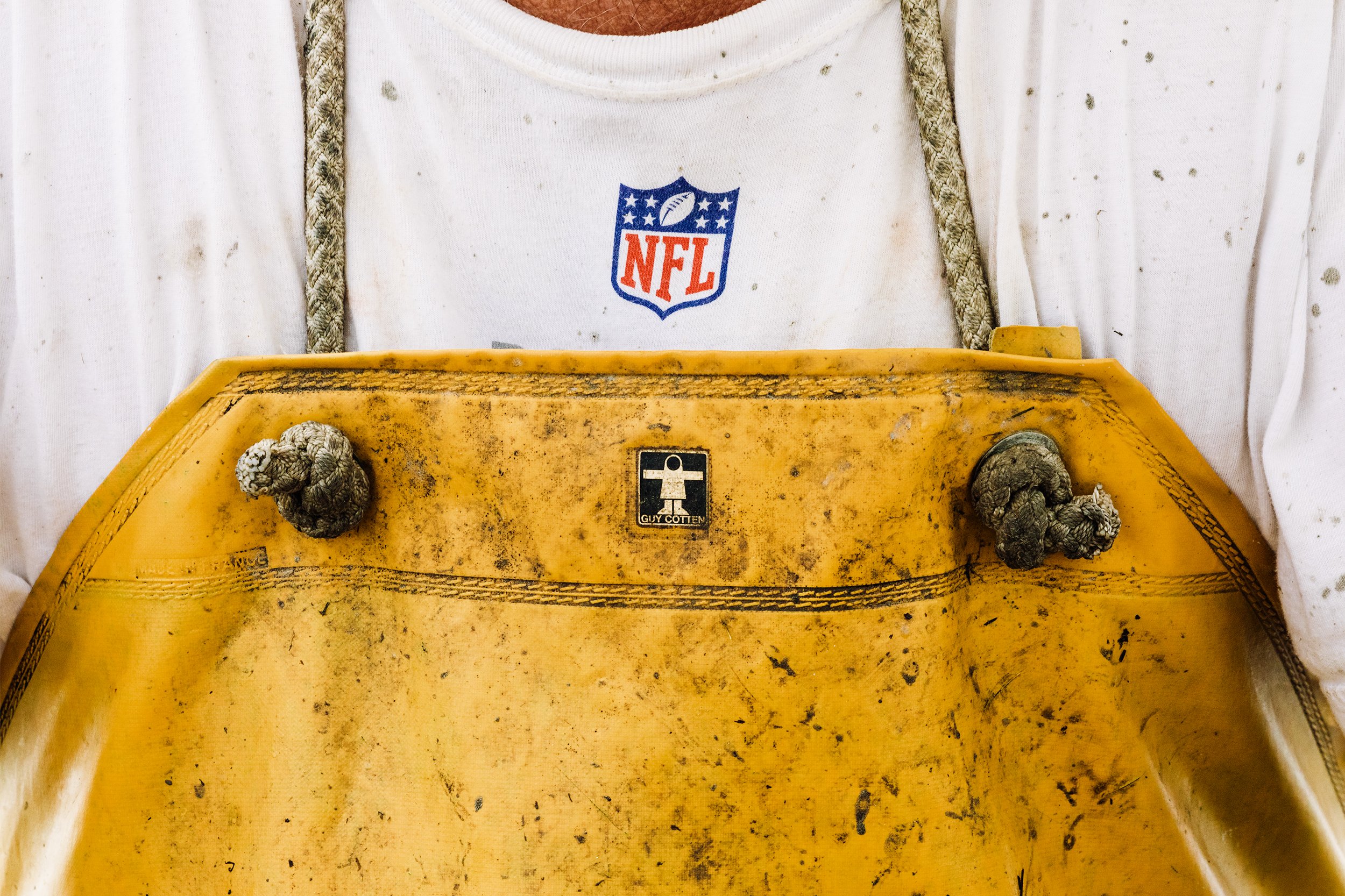
Mark Kitching, a waterman on Smith Island, dons a set of waders, the unofficial uniform of watermen. The rubber material provides ideal protection for the wet and dirty working conditions.
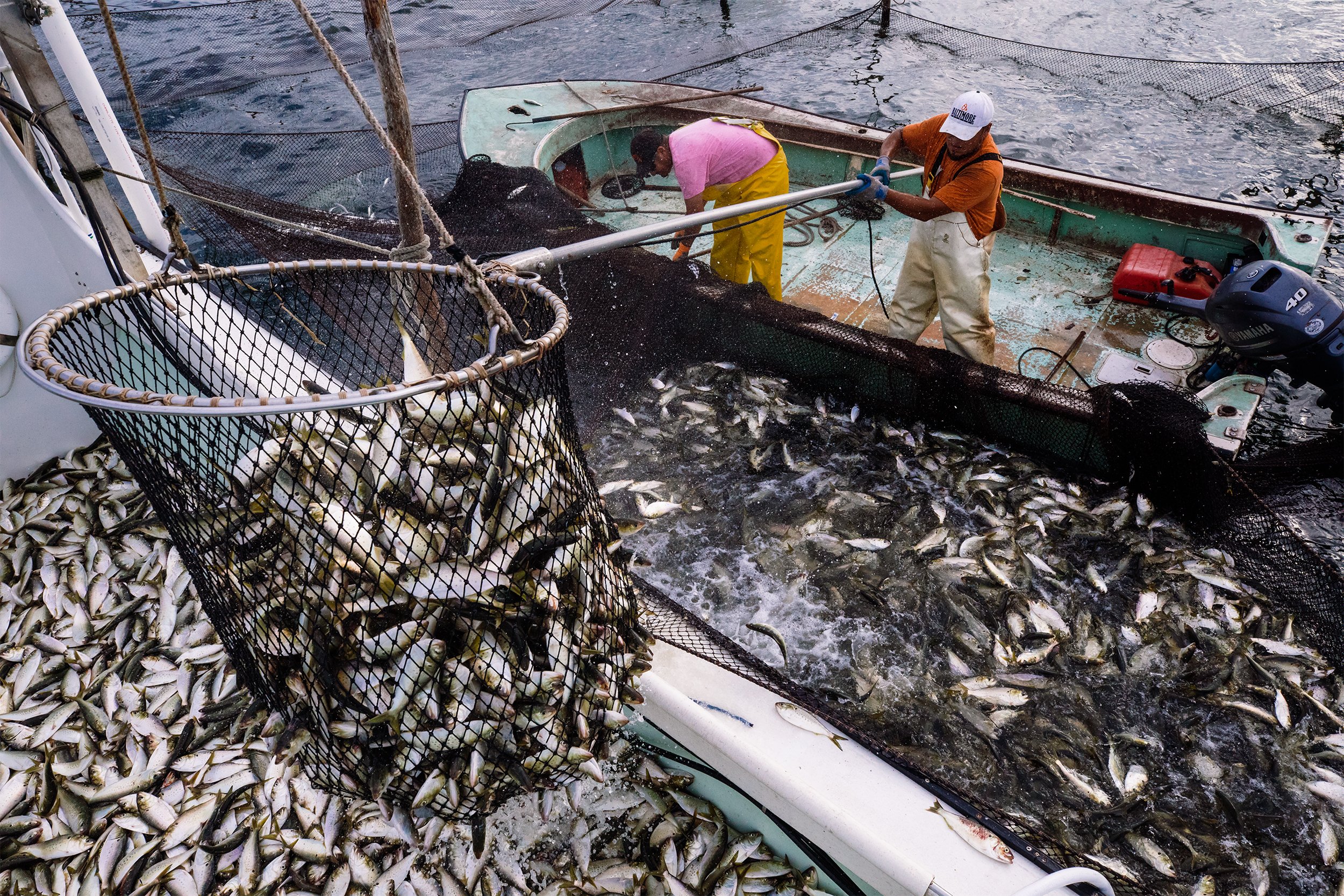
Hector Rene Modueño, left, and Edgar Riber transfer menhaden from a pound net into Captain Boo Polly’s boat near the shore of St. Mary’s County. The process of transferring fish onto the boat is physically intensive, leaving the crew wading waist-deep in menhaden on the ride to the processing plant. Menhaden are considered one of the most important fisheries in the Chesapeake despite not being harvested for human consumption. Instead, they are used in products like fish oil supplements, cosmetics and bait for other fisheries. Polly said the price of menhaden is down this season, which he attributes to the economic constraints of the Covid-19 pandemic.
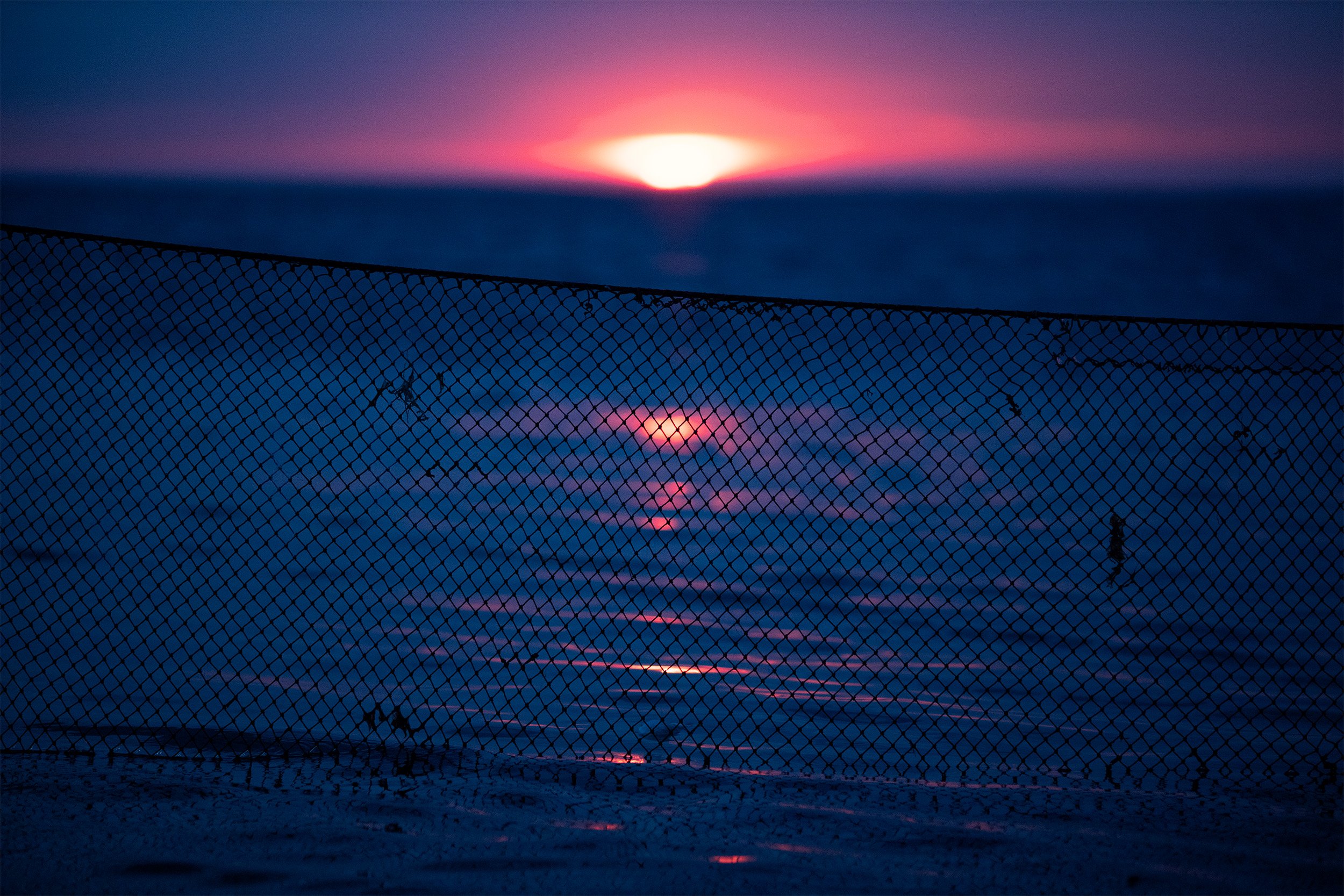
The sun rises behind Capt. Polly’s pound net. Work begins around 4 a.m. and continues until noon every day but Sunday throughout the fishing season. For watermen, witnessing many sunrises throughout the year is a cherished aspect of their work.
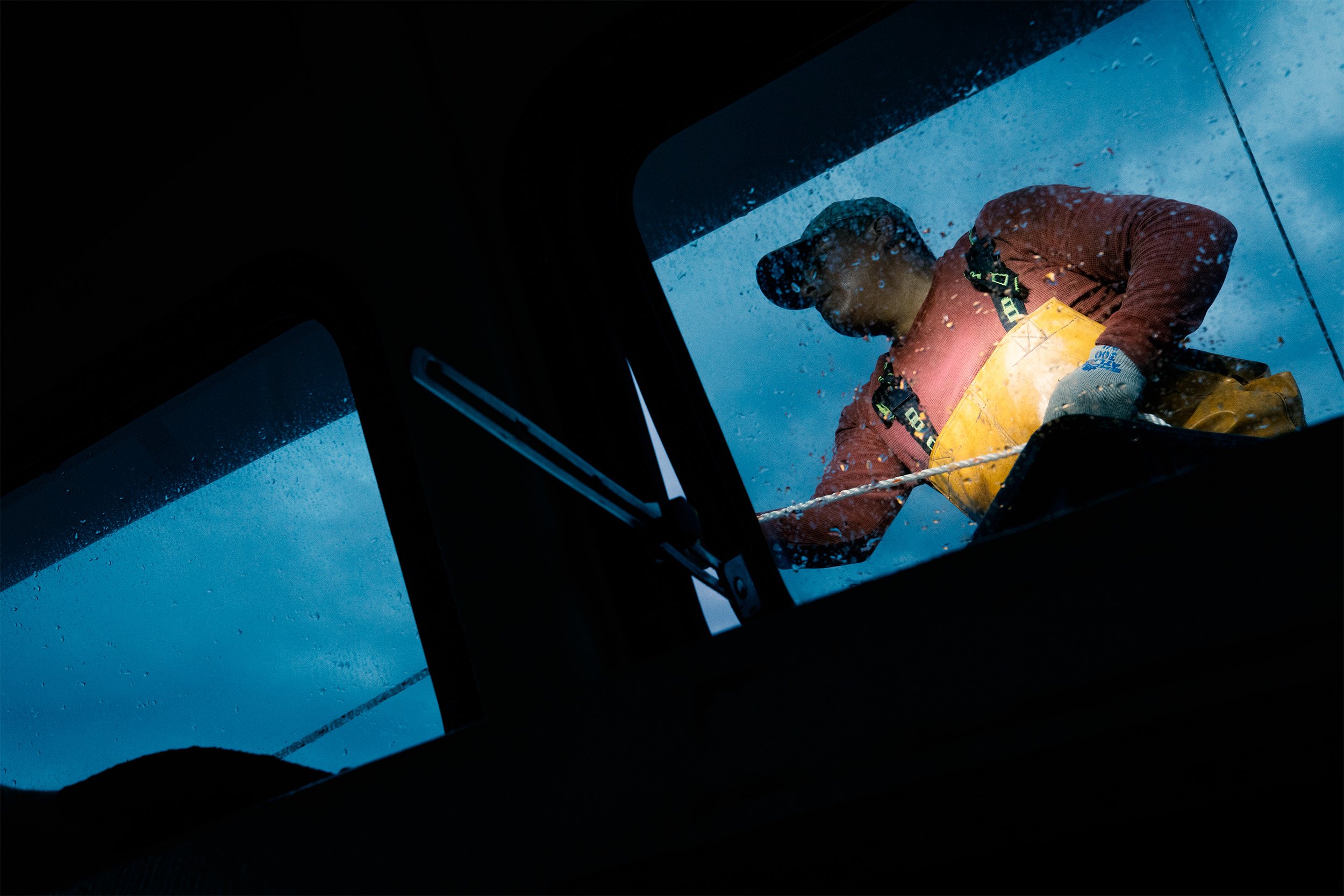
Zenon Vasquez begins prepping Capt. Boo Polly’s boat before sunrise before heading out to sea in total darkness.
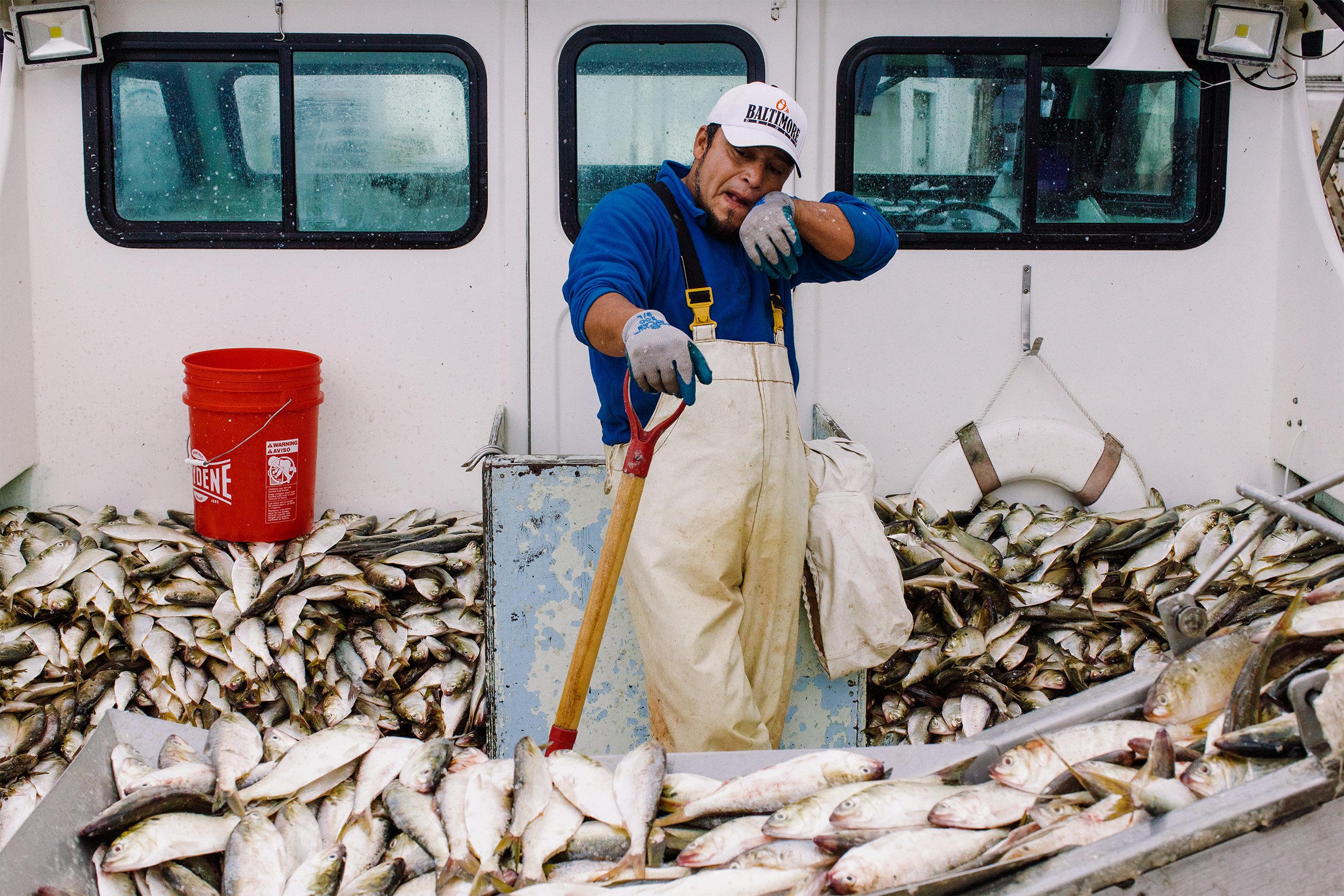
Edgar Riber wipes his face while shoveling menhaden onto a conveyor belt at Russel Hall Seafood in Hoopers Island. Much of the fishing industry is supported by Latinos that come to the United States on H-2B work visas. Catching sleep while on the boat, the men accomplish a full day’s work before many people wake up.
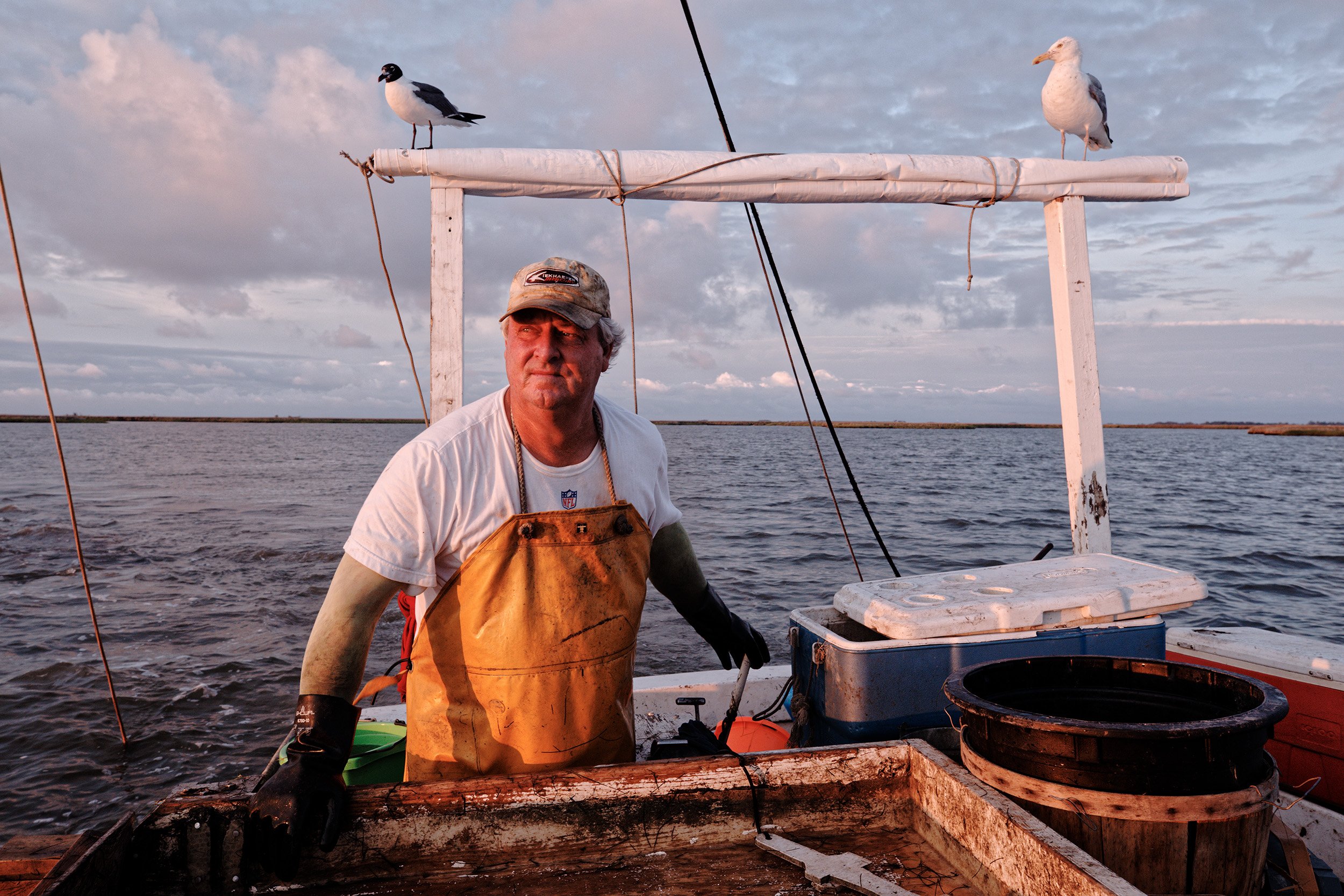
Mark Kitching looks out at his scraper while crabbing at dawn around the waters of Smith Island. Kitching relies on years of first-hand observation and local knowledge to weather the unpredictability of good and bad fishing years. “It’s an industry where one year you feel like you are on top of the world and another you could not be.” Kitching said. “Faith has always been something for us to make a living out of, and it hasn’t let us down.”
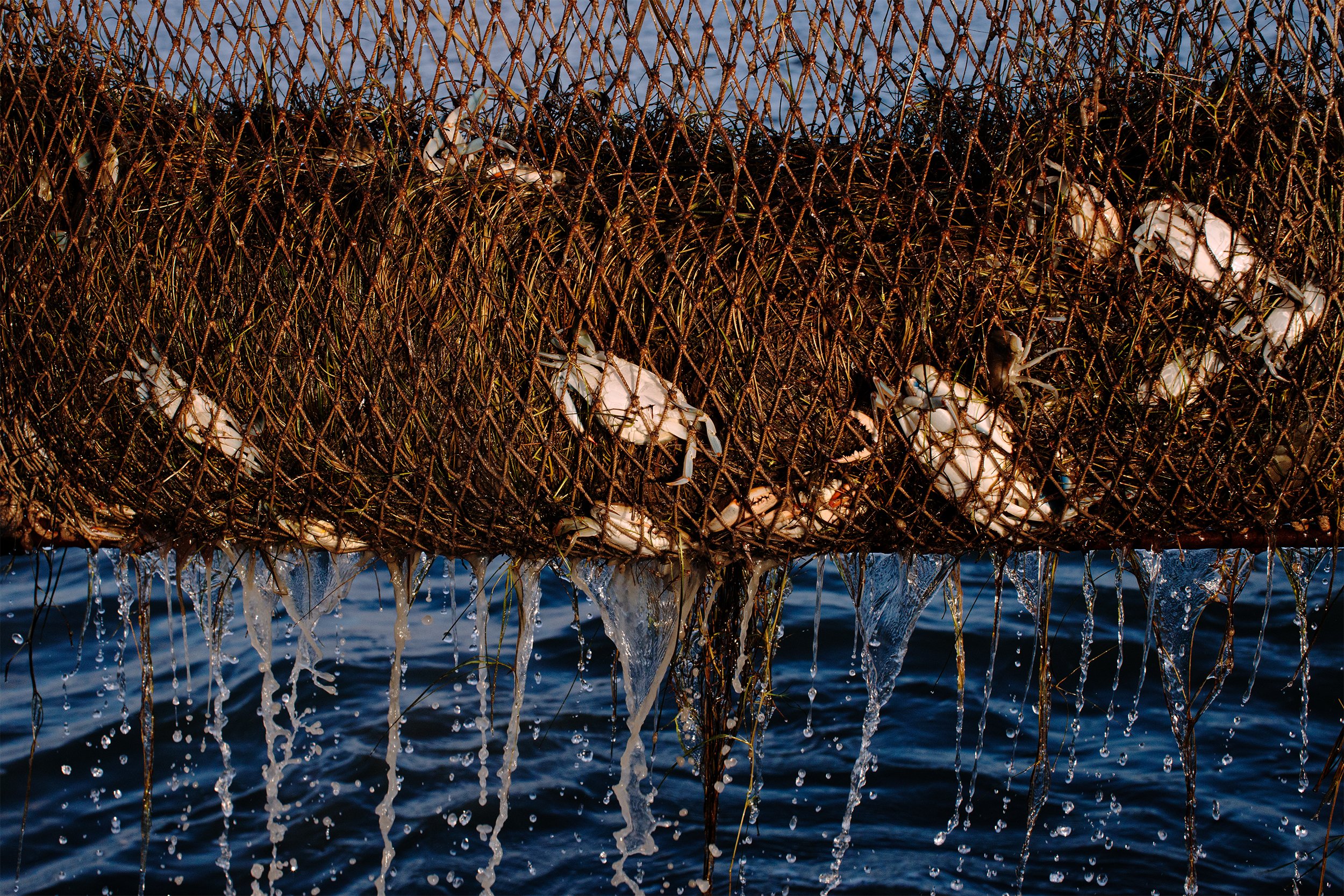
A crab scrape harvests blue crabs near Smith Island. Bay grasses are the foundation of the Chesapeake ecosystem, and has they continue to rebound due to pollution reductions, it means more habitat for blue crabs and other wildlife. The scrape consists of a net that is dragged across the underwater grasses in a way that doesn’t damage the sea bottom.
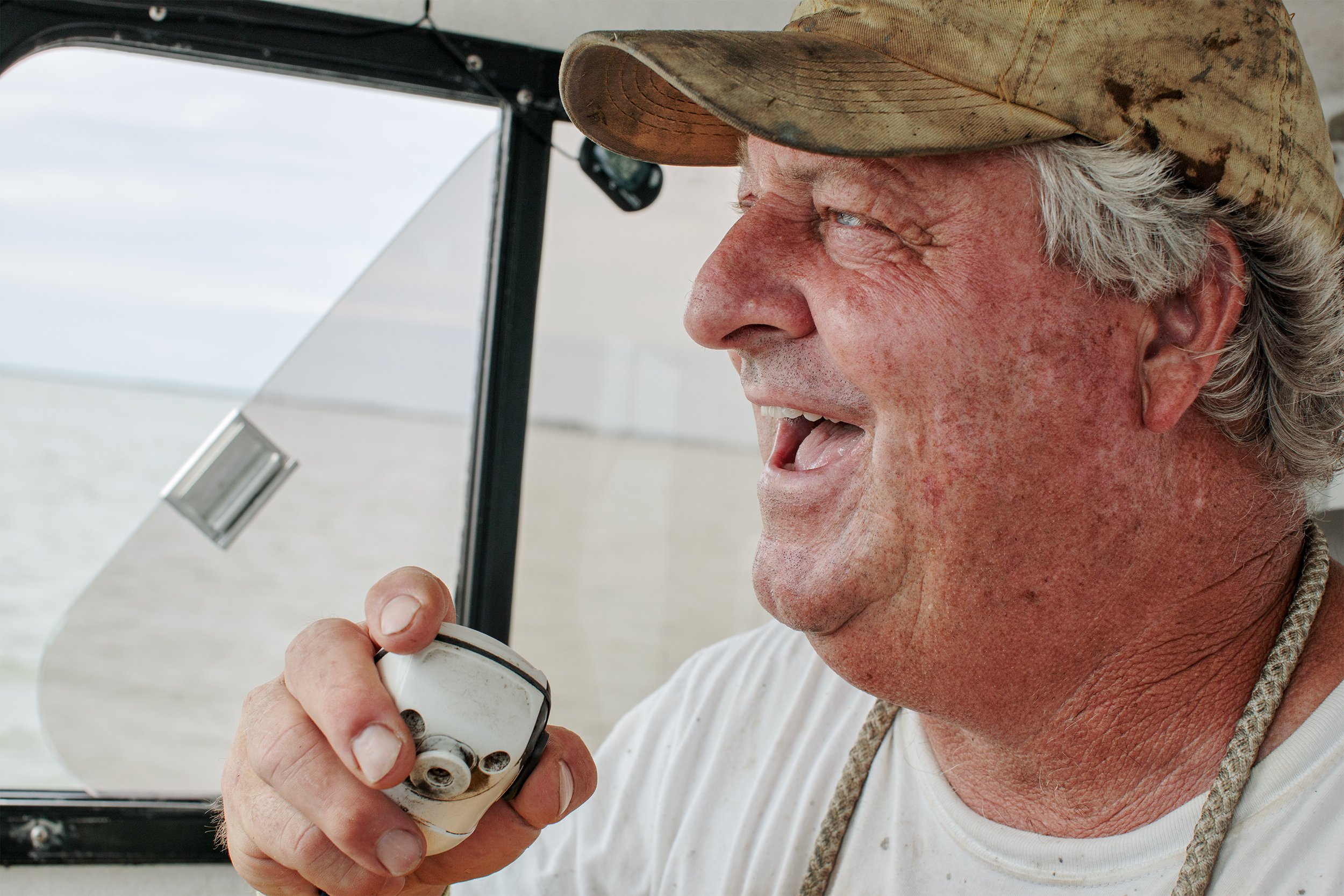
Mark Kitching jokes on the radio with other watermen while out crabbing on the Chesapeake. The friendly banter is a pastime and an informal means of updating fellow watermen on the state of the Bay.
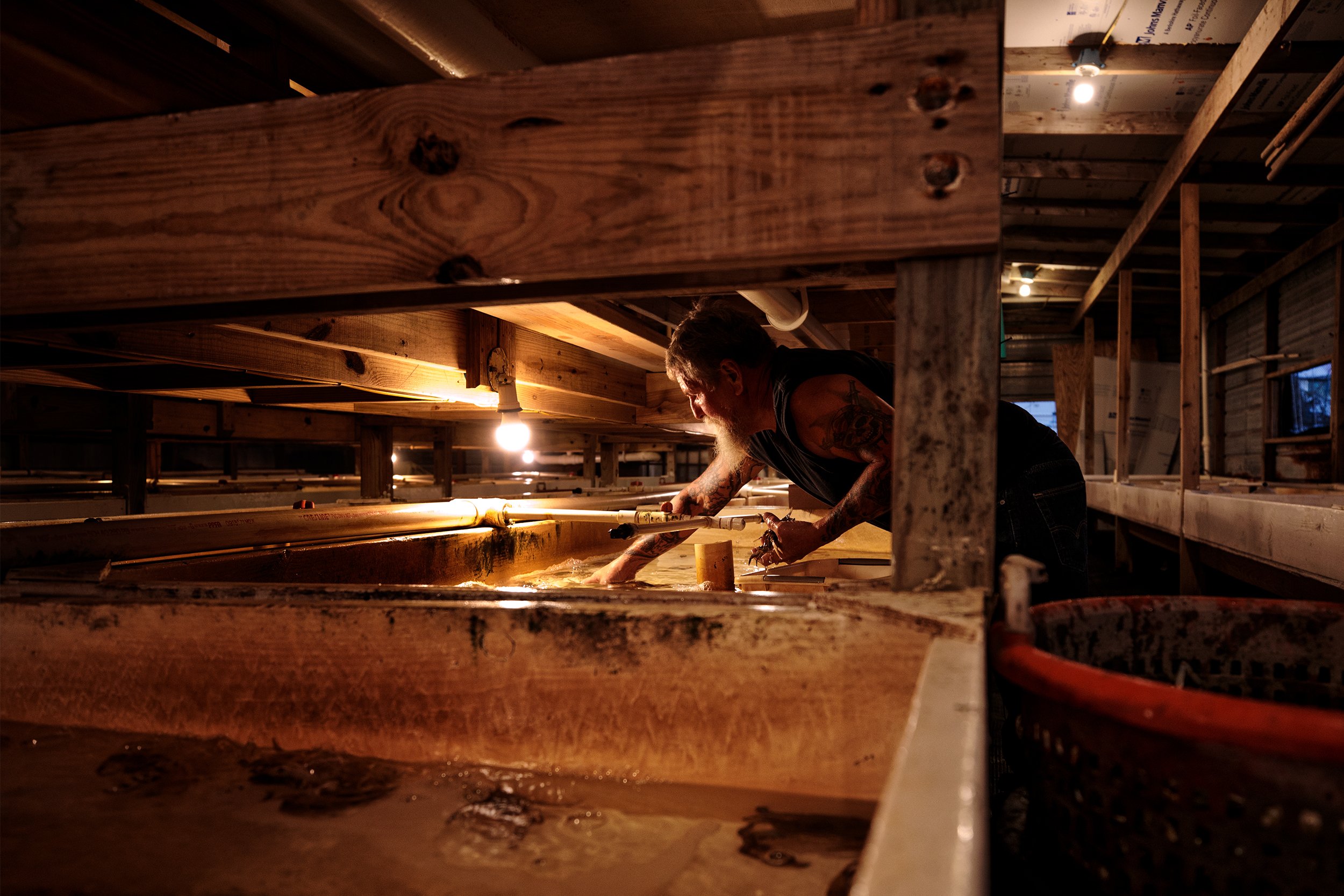
Clyde “Butch” Walters collects soft crabs in his shanty at Scotts Cove Marina in Chance. During the season, Butch works 900 crab pots out on the Bay six days a week. “I knew I was going to be a waterman since I was a boy,” said Walters, who quit school to pursue his dream. Owning his own business and the joy he receives crabbing out on the Bay is a sentiment shared by many watermen. ““You’re in that wild together,” Walters said.
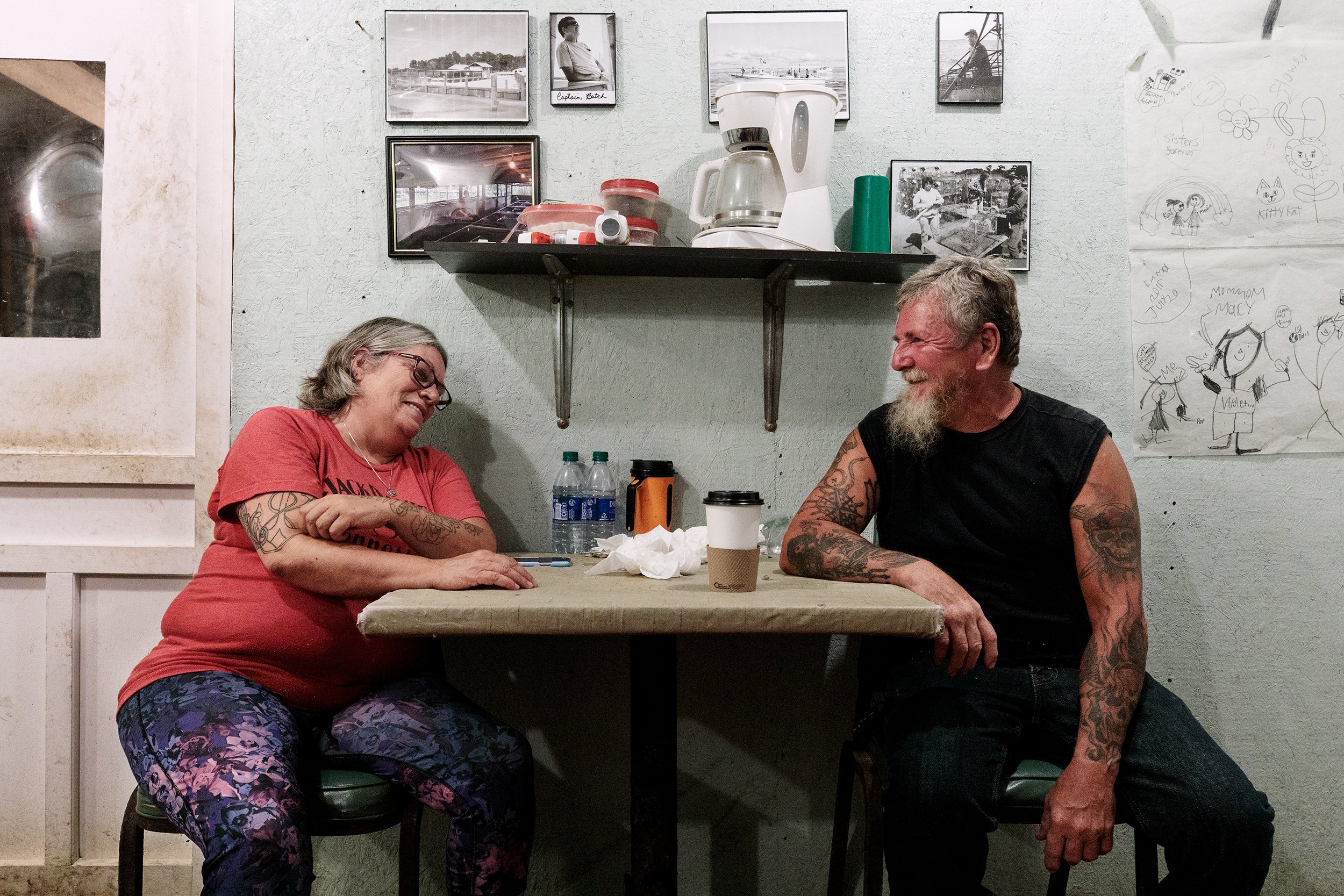
Clyde “Butch” Walters and his wife MaeBelle sit for a portrait in their crab shanty. Family photos and their children’s drawings hang above them. The couple have sold blue crabs together for 38 years, but between their three children, “none of them want to take over the business,” Walters said. “We will probably have to sell.” Butch said
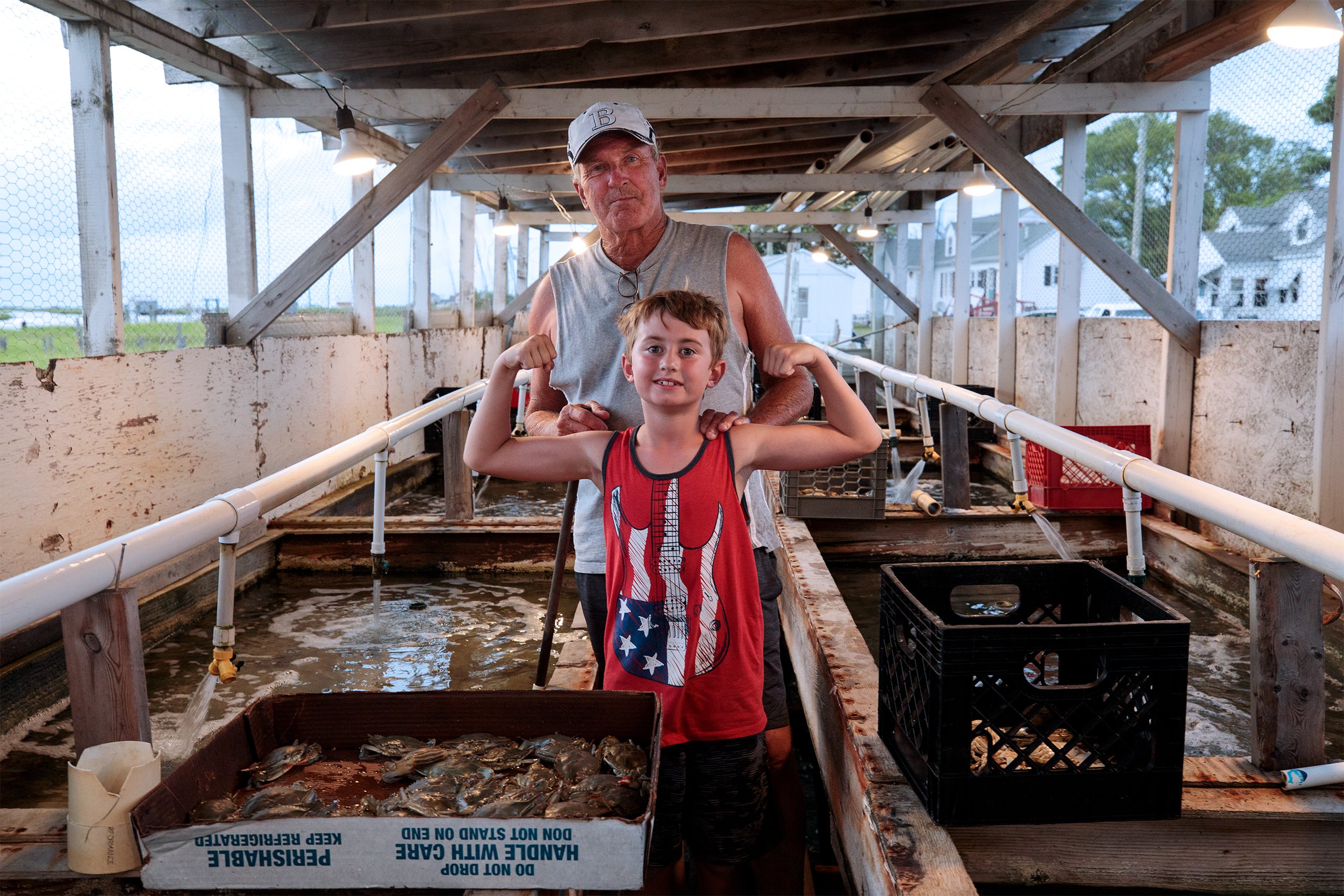
John Tyler, 64, and his grandson, Levi Somers, 8, stand for a portrait in Tyler’s crab shanty on Smith Island. Tyler started working the water at 11 years old, obtained his first boat at 15, and was working on his own at 16. Throughout his years on the water, he has seen a profitable industry turn into a continuous battle for survival. “[The] state of Maryland seems to not care about its watermen anymore,” says Tyler, describing the system of regulations and laws he believes is tone deaf to the needs and realities of watermen. He says there is a “perception that watermen will go out there and catch the last crab” that doesn’t reflect the sense of integrity and stewardship watermen bring to their work. Tyler feels the working for conditions for watermen are becoming impossible, with few alternatives. “I’m 64 years old, what the hell am I going to do,” Tyler said. If the watermen profession dies, “there’s a lot of knowledge that’s going to die with it.”
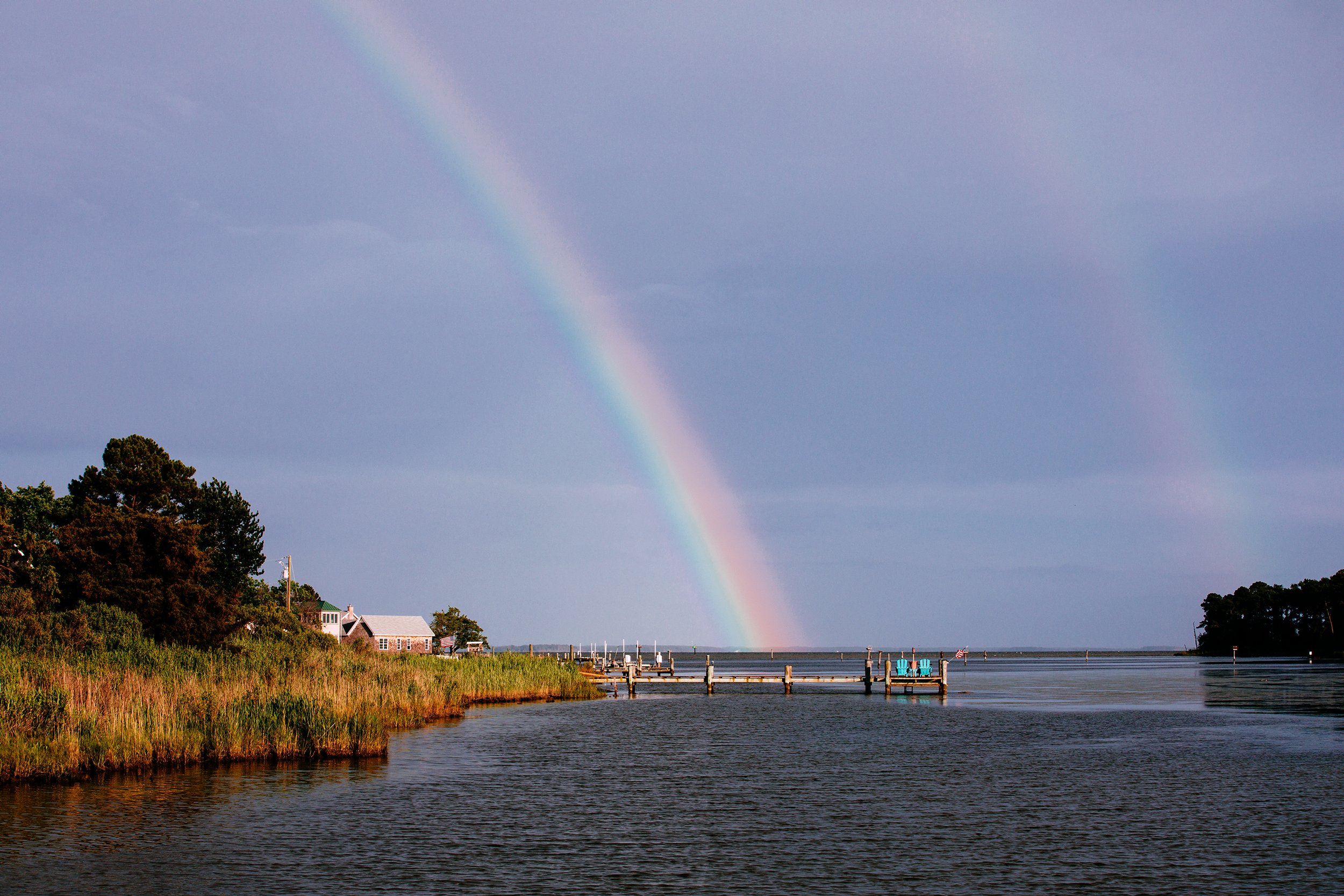
A double rainbow appears after a cloudburst passed over Tilghman Island. Areas like Tilghman Island are still home to smaller traditional waterman communities, but have also been subject to gentrification and an increase in summer homes.
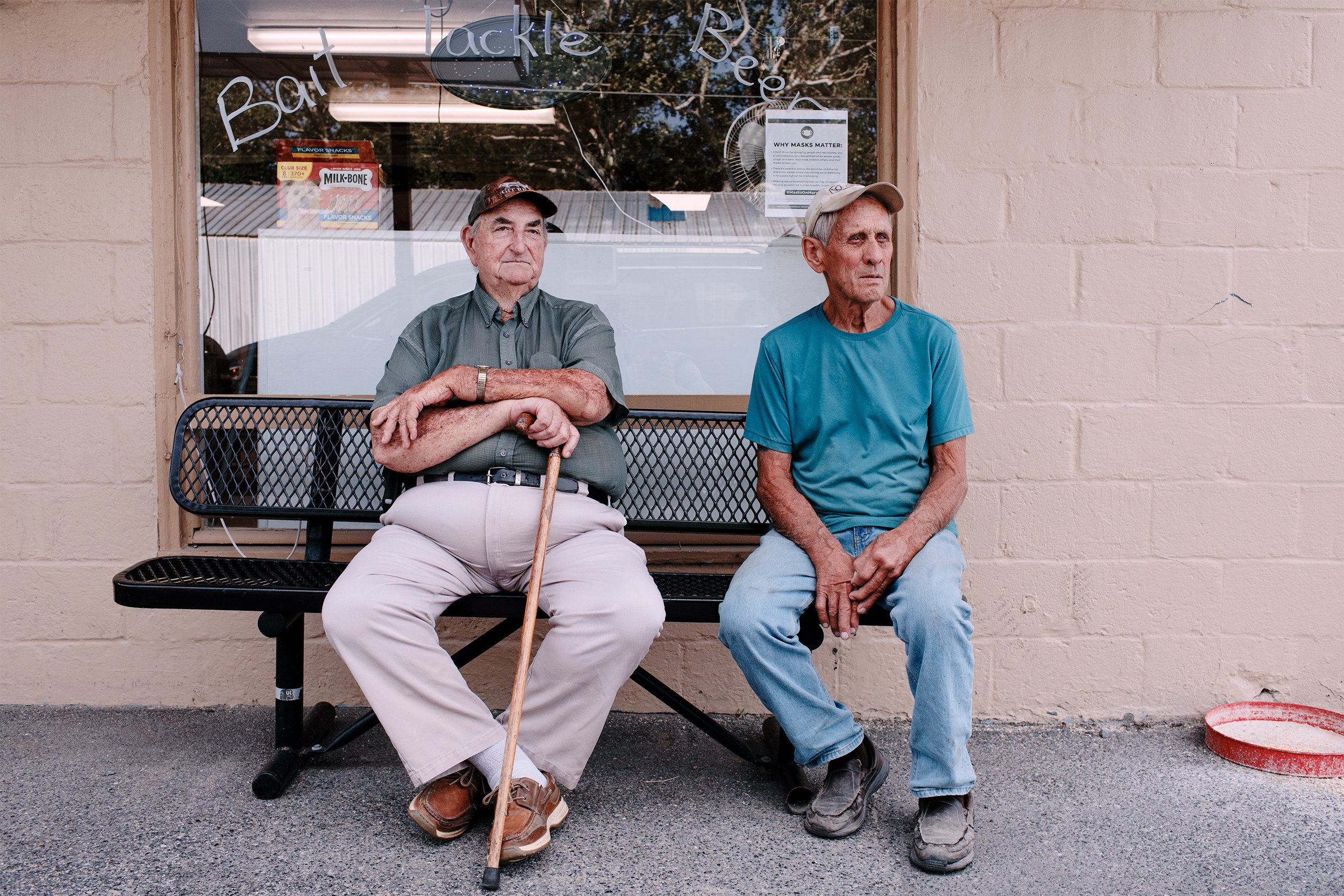
From left, Stanley Larrimore, 90, and John Kinnamon, 83, sit outside of Fairbank Tackle in Tilghman Island, where the local waterman community would pass time before and after fishing. Larrimore said it “used to be so full of people.” Larrimore started working the water in 1947, learning from his father Glendy. He eventually dredged oysters with his own skipjack, Lady Katie, until 1999. This was the same boat President Ronald Reagan stood upon to deliver an address about the future of the Chesapeake in 1984. Kinnamon began crabbing in 1969, and still does to this day. “That glare of that water is tough on you,” Kinnamon said.
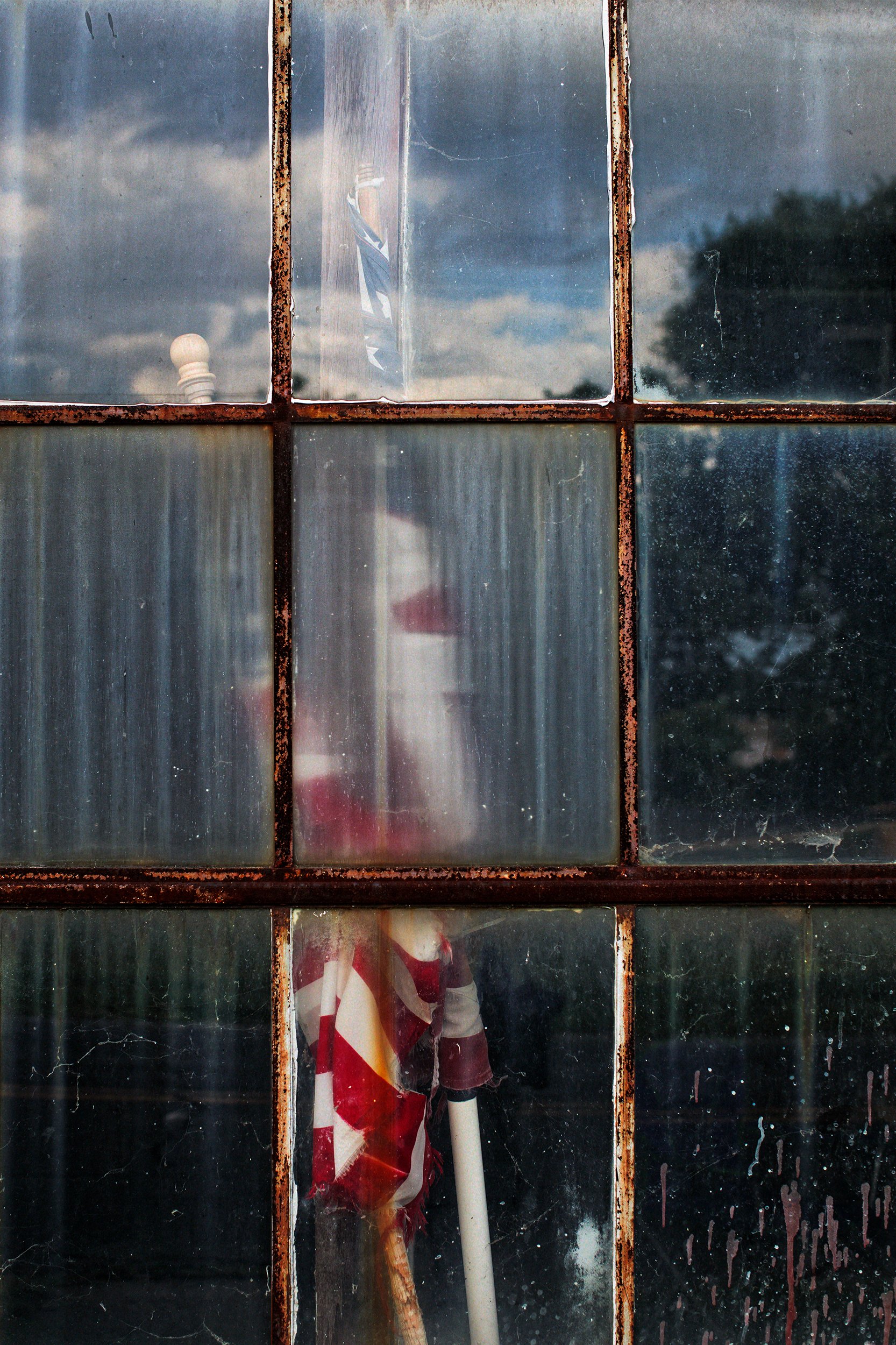
American Flags rest inside the shuttered Phillips Packing Company in Cambridge. The plant was once the largest employer in Dorchester county. Today the property is the focus of a restoration and revitalization effort by the Eastern Shore Land Conservancy.
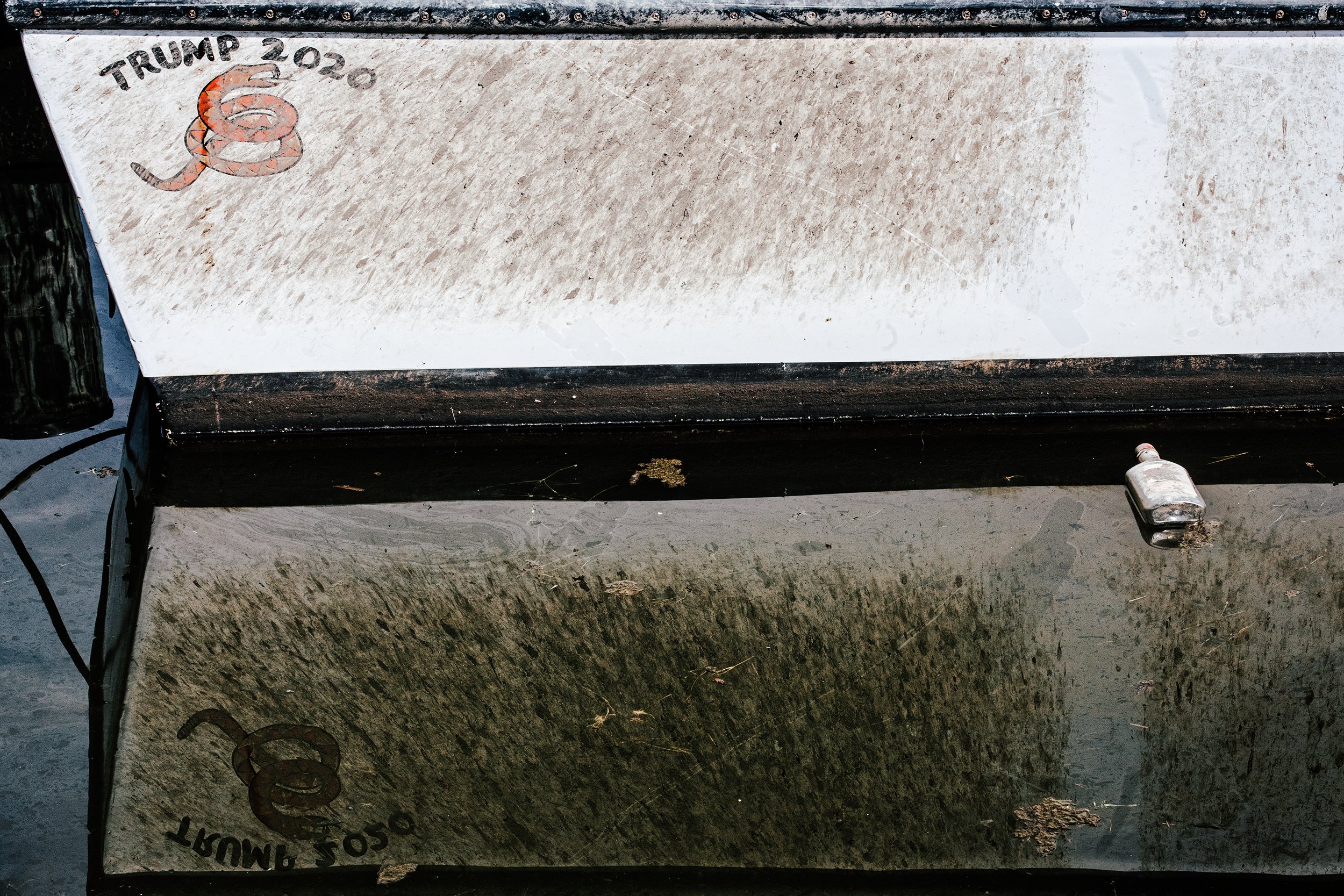
A painted fishing boat in Tilghman Island voices its owner’s support for President Trump, whose administration has acted to reduce the number of visas available to seafood processors. Watermen are predominantly conservative and Trump flags fly from many workboats
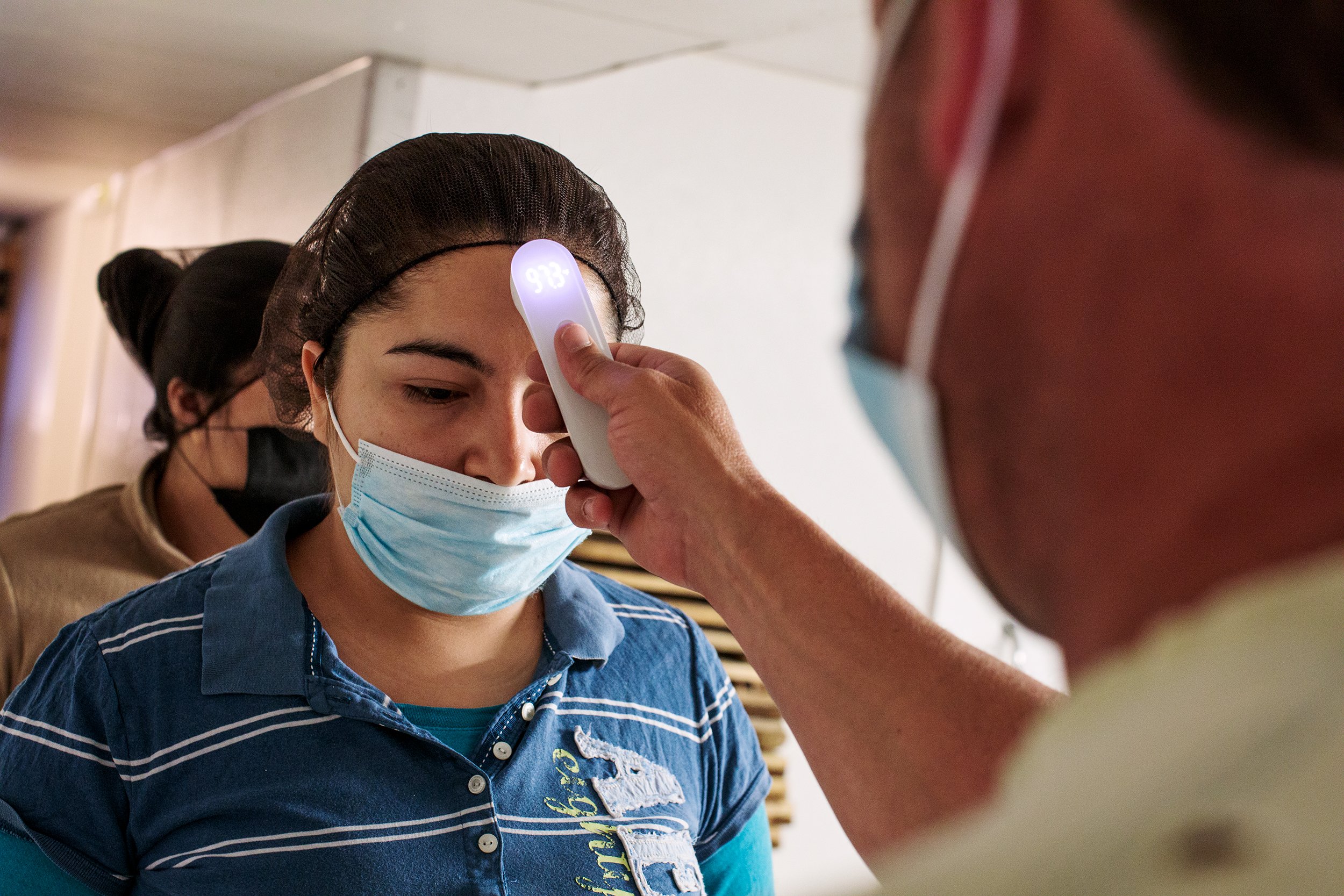
Workers operating under the H-2B visa program have their temperature checked before picking crab at Russel Hall Seafood in Fishing Creek. Covid-19 has forced seafood businesses to adapt to new social distancing and health protocols.
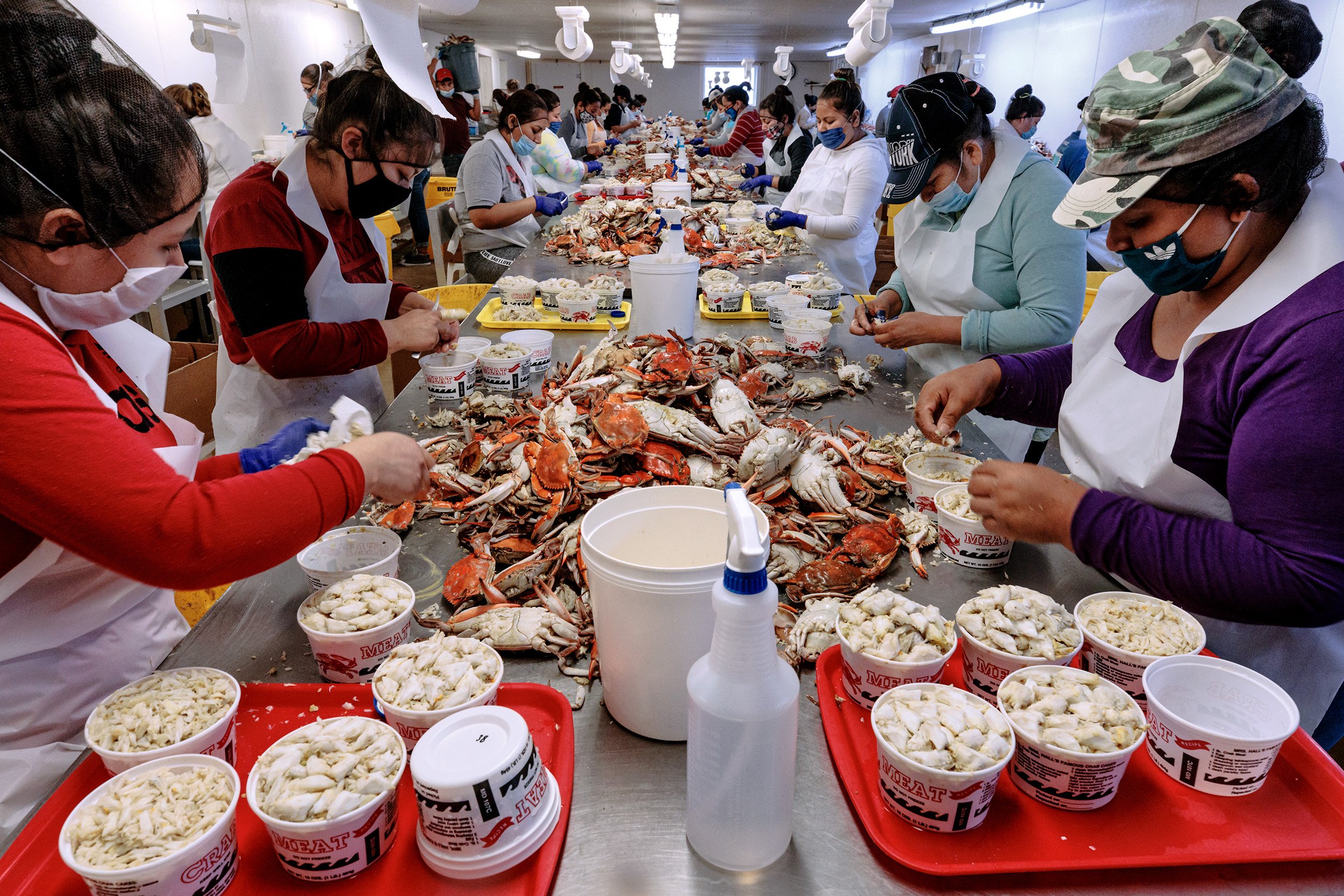
Workers pick crabs at Russell Hall Seafood. Russell Hall is one of only two out of the five picking houses on Hoopers Island that were awarded visas for workers this year. Mark Phillips, son of Russel Hall owner Harry Phillips, says “it doesn’t just hurt his business, but the whole community,” as watermen have fewer places to offload their catch. “We’ve had job fairs everywhere, Baltimore to Washington, people just aren’t going to do it,” Phillips said. “If I had to run this business and rely on Americans, I’d sell it today.”
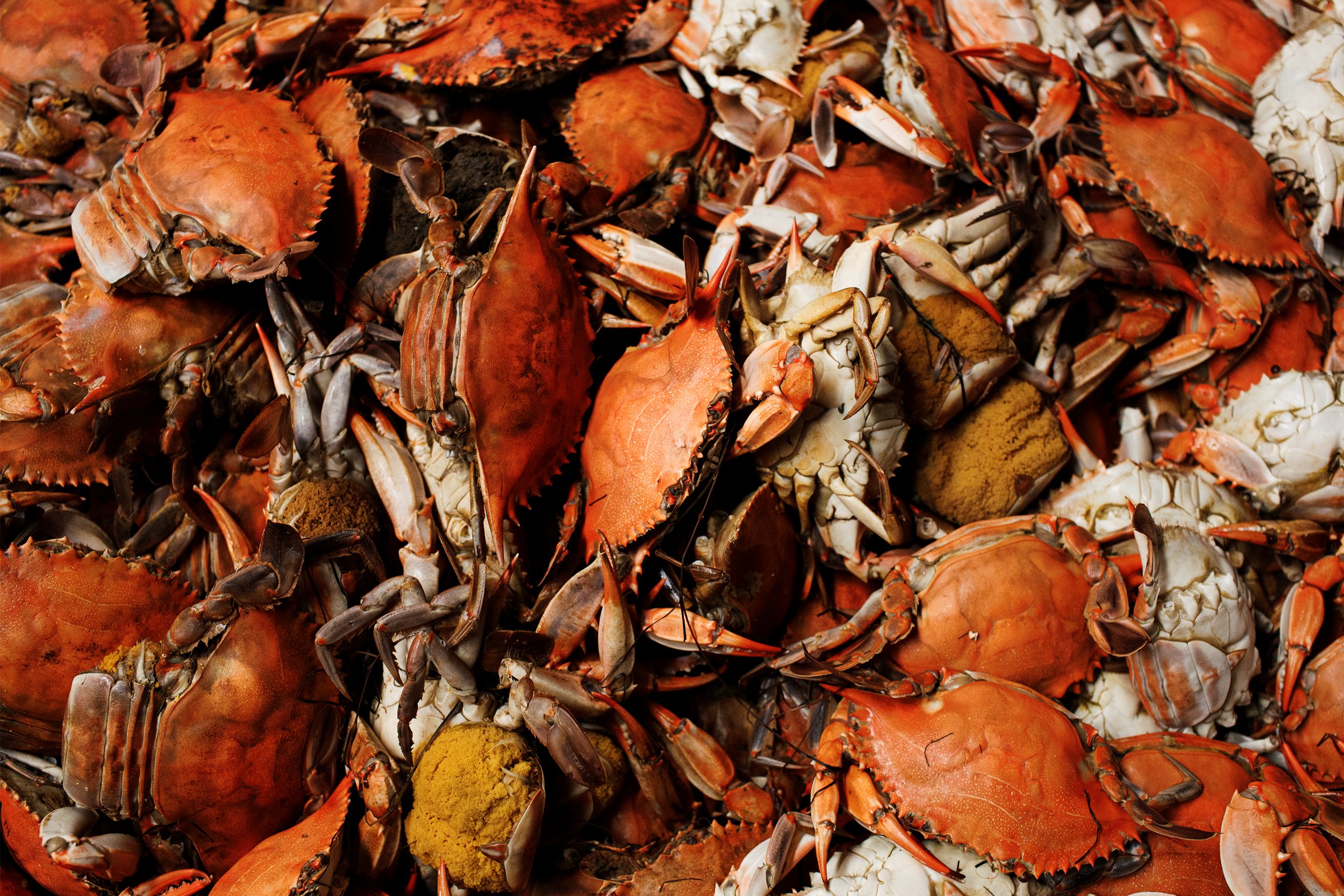
Blue crabs are pulled out of an industrial steamer at Russell Hall Seafood. Each crab will be hand-picked before being shipped and sold as lump crab meat. Sponge crabs—female crabs that are carrying unhatched eggs—are only legal to harvest in Virginia. Each sponge may contain anywhere from 750,000 to 8 million eggs, with the average sponge containing 2 million already fertilized and developing crabs.
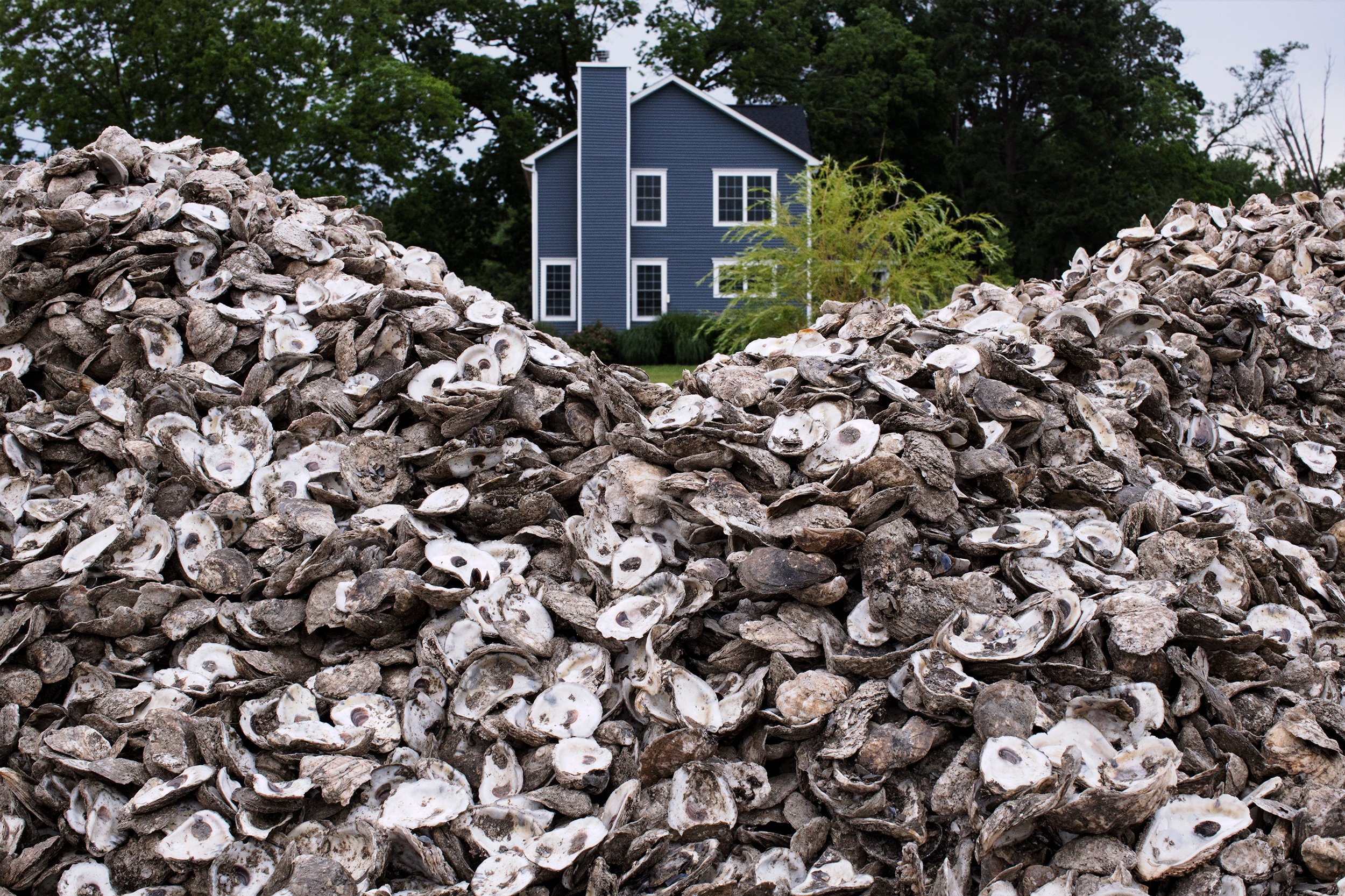
The house of Nick Hargrove, a partner at Wild Divers Seafood, lies behind a pile of oyster shells in Wittman Wharf. The shells are recycled as fresh bottom for baby oysters to attach to and grow from in the aquaculture process, a growing industry in the Chesapeake region. At its peak in the late 1800s, roughly 20 million bushels were pulled from the Bay each year, but over-harvesting, disease and habitat loss have reduced the oyster population to less than 1% of historic levels.

Scott Robinson Jr. erases the whiteboard used to list oyster orders at Madhouse Oysters, an oyster farming company on Hoopers Island, Md. Since Covid-19 struck, restaurant closures and menu reductions have reduced the demand for live oysters and led to a surplus. If oysters can’t be sold before they grow too large to easily slurp at restaurants, growers may not be able to find alternative markets for their product.
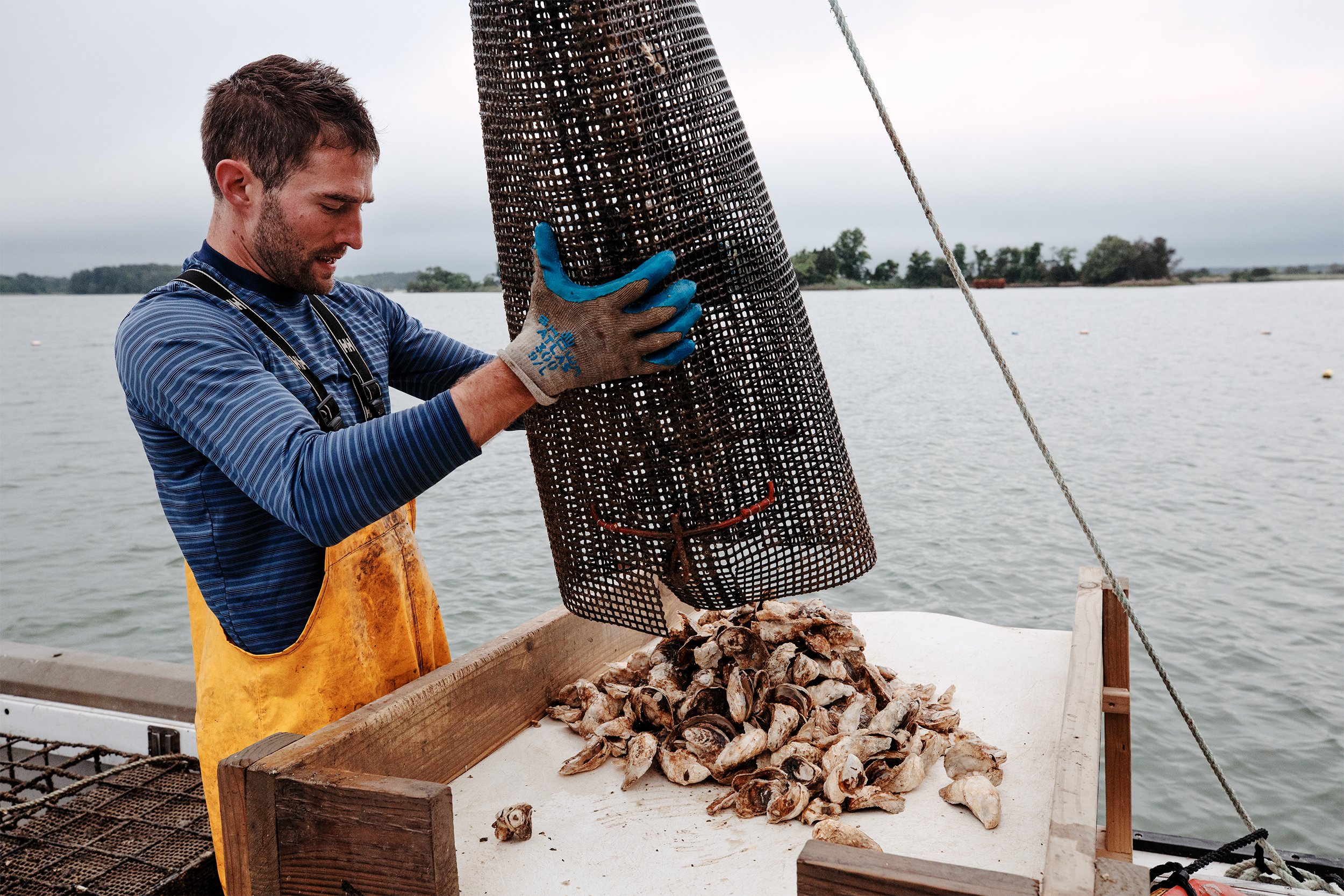
Isaac Wilding of St. Michaels Oyster Company harvests oysters from his leased oyster farm on Cummings Creek in Wittman. Wilding began growing oysters three years ago as a passion project, with oyster seed from Phillips Wharf Environmental Center in Tilghman Island. His method is “low and local” which has allowed him to slowly grow his business. The image of modern watermen is shifting as new economic opportunities like aquaculture become more easily accessible. Wilding says that he is “not totally welcomed” by watermen who “are traditional in their ways.”

Jozie Wilson works the storefront at Wittman Wharf Seafood in Wittman. The company opened a storefront at its shucking house location in response to Covid-19, as restaurant closures hurt their business profits. The move was a success, as news of the store spread to the local community and calls started coming from states as far away as New York according to Marc Van Pelt, a partner in the business.
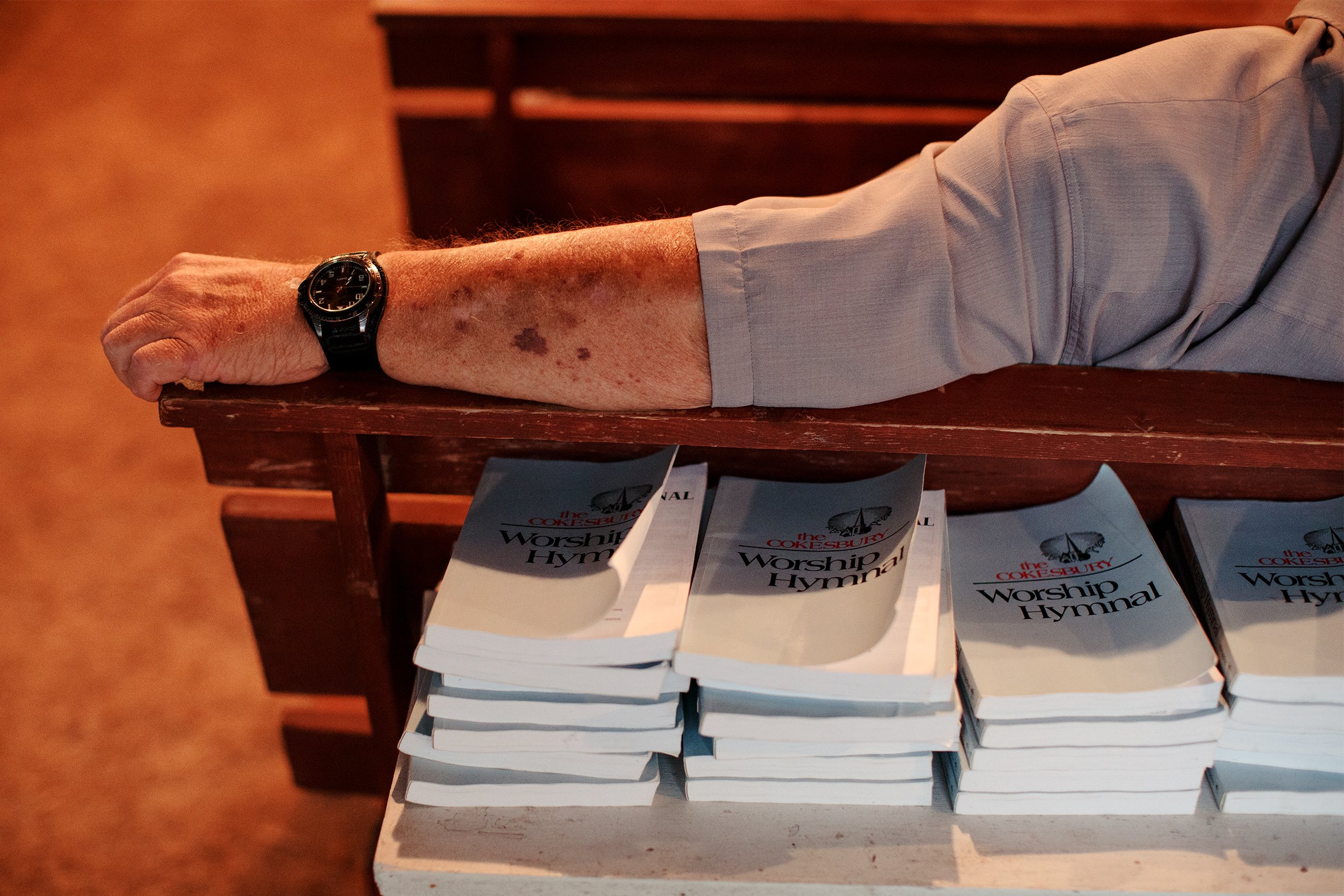
Worship Hymnal books lie behind Captain Terry Laird in the camp meeting ground of Smith Island United Methodist Church. The 134th annual Camp Meeting is a cultural and religious tradition for Smith Islanders that brings nearly all of the community together. “If a season is bad, God is going to provide for us,” Rev. Everett Landon Sr. said.

A copy of An Island out of Time, a memoir of the Smith Island Community, sits on a coffee table in the Smith Island Inn.
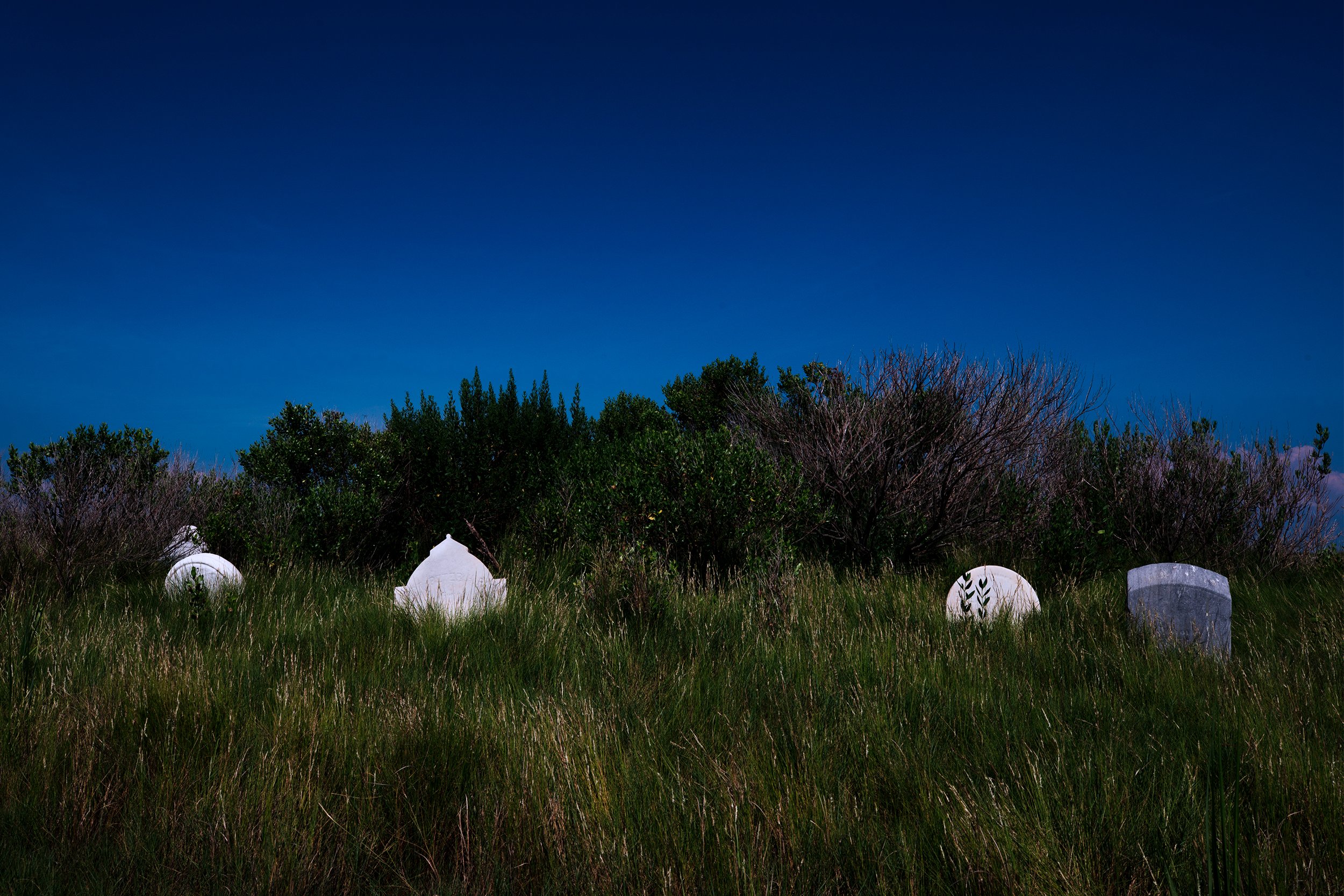
The graveyard of Holland Island Methodist Church is one of the last visible remains of the community that once inhabited the island. Holland Island has been sinking into the Chesapeake as the landmass is eroded away by heavy winds, seas, and storms.
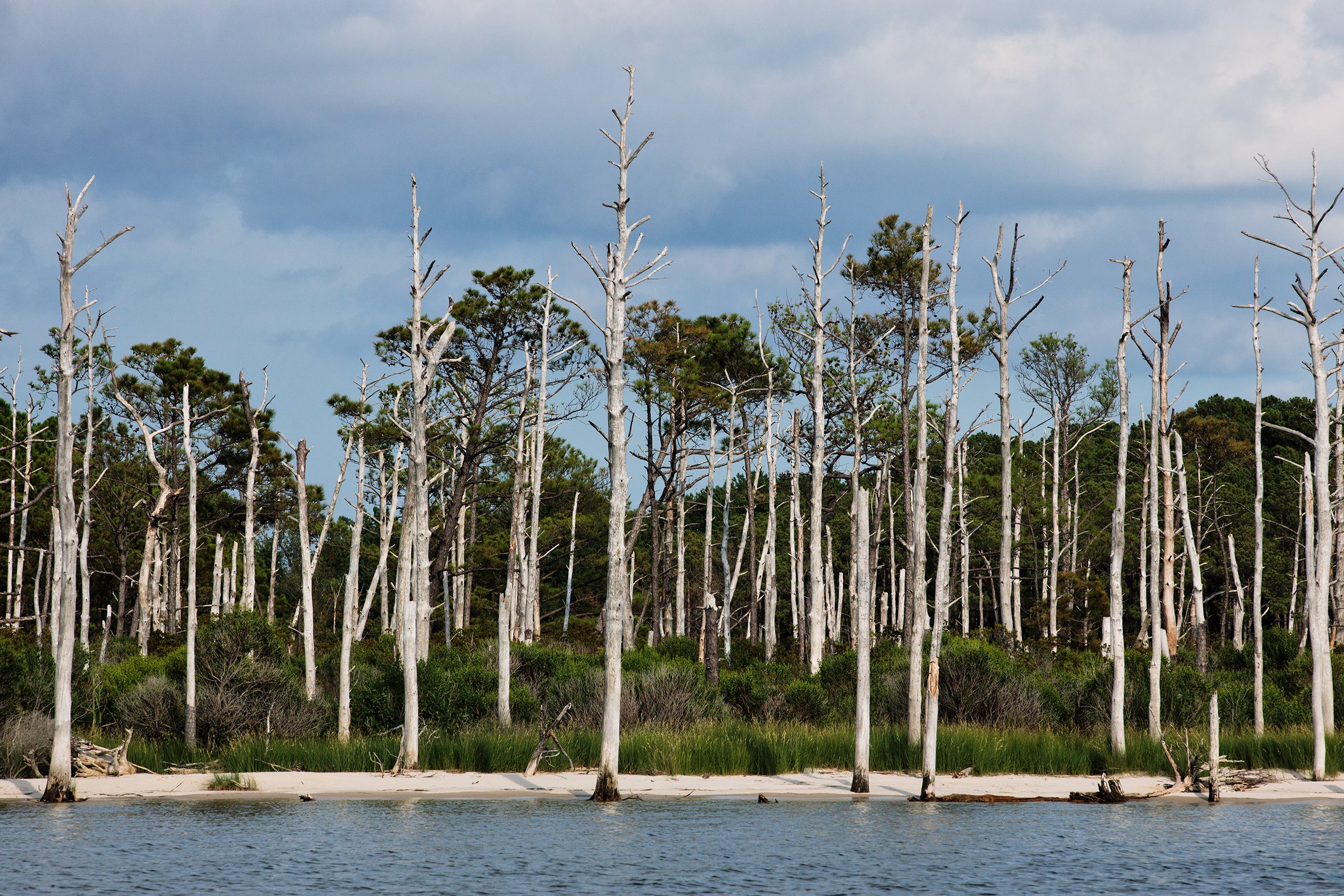
A ghost forest of loblolly pines on Deal Island is the result of sea level rise and shoreline erosion. As the brackish water encroaches further into the root systems on land, it kills off the trees that cannot handle the salt content.

Clyde “Butch” Walters looks for arrowheads on Adams Island. As the shoreline continues to erode, once-buried artifacts begin to surface after each major storm. The Eastern Shore and much of the Chesapeake region was home to Algonquian-speaking indigenous populations before European settlement, and several tribes continue to live in the region today.

Arby Holland smokes a cigarette on the patio with Sharlene Thornton, while his wife Debbie peaks outside to check on customers. Like many fishing towns, Arby’s is the only location on Deal Island where locals can get food and supplies. Since the pandemic began, shelves of tackle remain empty, but the store also functions as a bar and grill that has been doing well because it is the “only place to sell” crabs, Holland said.
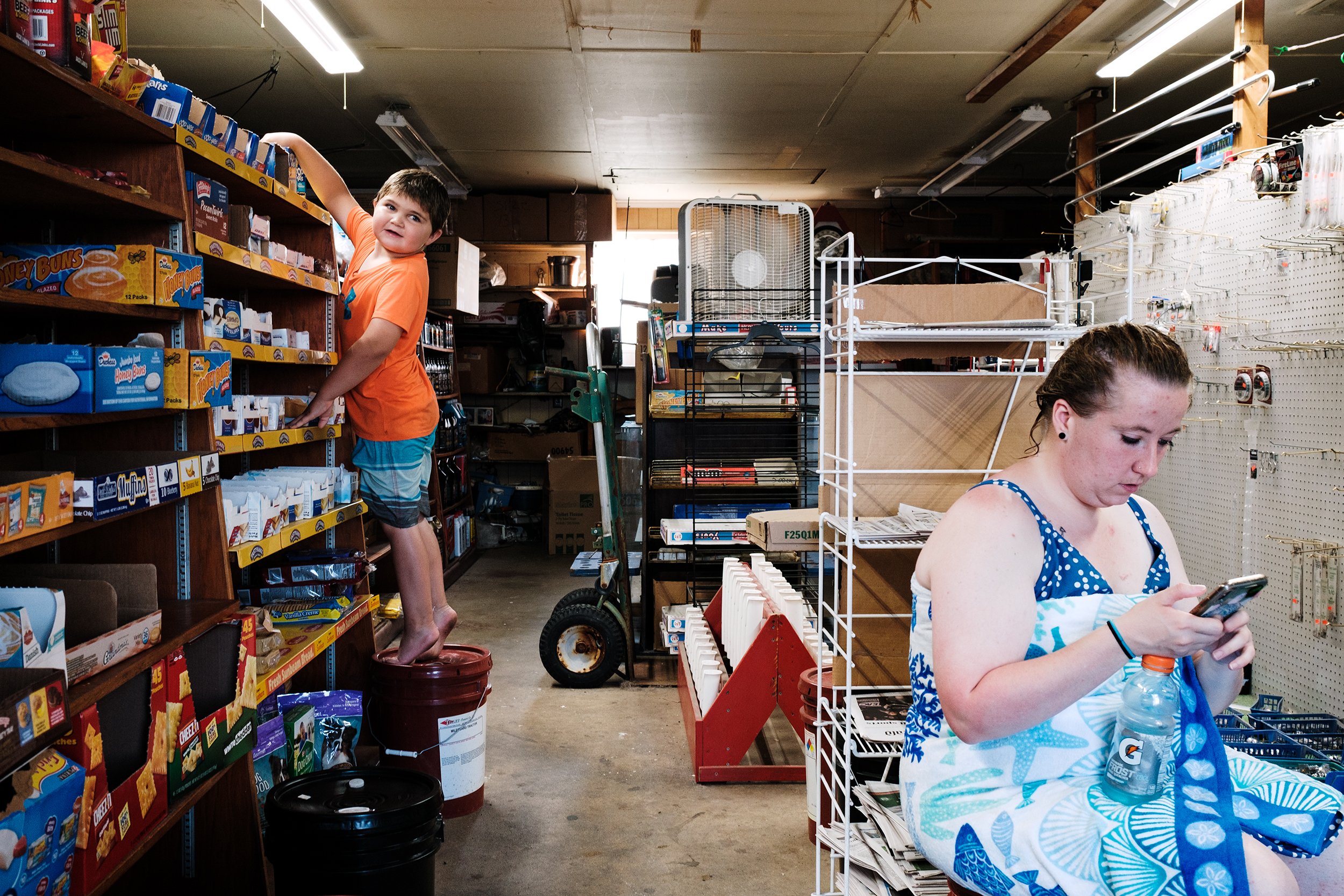
Luke Holloway, 6, reaches for Pop-Tarts at Arby’s General Store in Deal lsland, while Kelsie Holland checks her phone. The bait and tackle rack has been empty since Covid-19, due to a lack of tourism.

A baby blue crab pulled up with a crab scrape. Crab populations vary year-to-year, making the number of juveniles a good predicator of future harvests.

Kevin and Lou Czarniewy enjoy a sunset on the beach away from the confined lifestyle of Washington during the pandemic at the Deal Island Marina on Deal Island, Md. For 12 years they have owned a second home in Deal Island, where they enjoy the area’s natural beauty. An influx of “summer home” owners has become more common in historic watermen communities. Behind them lies a pile of oyster shells used for bottom in oyster aquaculture. Shell piles were once seen all over the Chesapeake, reminiscent of a booming industry.